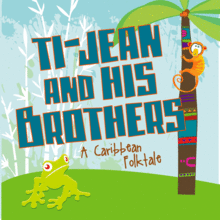Reality can be messy and the truth can be complex or illusory. In fact, contrary to how we normally perceive our world—stable and fixed—the truth is that our world is as unstable and variable as dreams often are. Truth is marred by people’s opinions and is twisted to flow with the agendas of the age.
Since this world of physical existence is so wobbly in our perception of it, it is no wonder that myth has pervaded our consciousness in such profound ways. Folktales that nail down truth so that it cannot escape are told to our children. Fables, parables, and allegories seek to make sense of a world that legitimately cannot be grasped.
“Ti-Jean and His Brothers: A Caribbean Folktale” is no different. While simple in its execution, setting, and characters, this was exactly what was necessary for it to be so powerful. Set in a rainforest of an unspecified island in the West Indies, “Ti-Jean” is about survival and family–both physical and spiritual–and the oppressed vs. the oppressor.
Mother (Priscilla Ozodo) is the single mother holding together a family of young men: Gros-Jean (Carlos Barranco), Mi-Jean (Ronald “RJ” Barnett), and Ti-Jean (Toan Nguyen). Each boy is different in the way he approaches the world, and each is a representation of human ingenuity. A cast of animals is the perfect foil for these young men as they each take a journey into the world. From the breeze of the Bird (Roodlyne Altidor) to the blaze of the Firefly (Franceska “Frankie’ Bruny); from the wet Frog (Shelly Greaves) to the dusty Cricket (Elijah Malo); these characters reveal nuanced details about the human characters and spiritual entities later on.
From the first eerie cry of Bolom (Michelle Bartlett), the unborn child of Mother, “Ti-Jean” promised to be more than simply about the physical world. The ensemble (Lisabeth Almeida and Michelle Orellana) served as spirits and symbols of the spiritual world, while their second identities were that of trees–perhaps hearkening back to the animistic tradition present with early religious peoples.
The showstopper, by far, was the character of the Devil/Old Man/Planter (Indigo Bishop). The seamless transition from varying personifications of evil, each with a different costume and voice, was engaging, terrifying, and thrilling.
As Gros-Jean the strong, Mi-Jean the intellectual, and Ti-Jean the wise each journeyed out into the world, the Devil preyed on them one by one. Interestingly enough, the only brother who survived was the one who implemented not a different outward brilliance, but an inward peace. Ti-Jean triumphs because he took his God-given wisdom, the wisdom of his mother, and the wisdom of nature, and turned it on the Devil. Alone, Ti-Jean states, we are rotten, but together we are strong. Paired with this moral of unity, we find one last bit of wisdom in “Ti-Jean,” and it comes from the mouth of the Devil: “the features will be different, but the battle will be the same.” Evil is not going to be outsmarted or killed with brute force; evil is like darkness. It is our job to show our light, or as Ti-Jean did, light a grand fire. Metaphorically speaking, this is a primary moral of the folktale, and a timeless one indeed.
In the end, we can take the small and the folktale and extrapolate it outward into our world. We can take our knowledge of folktale truth and apply it to our messy world of reality. This is the beauty of theater; this is the aspiration of art.

